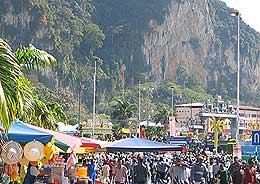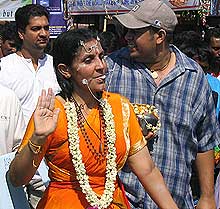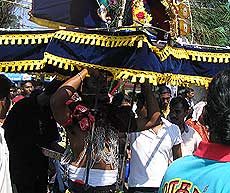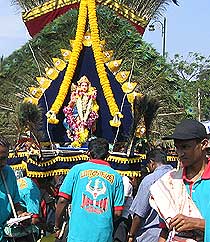HINDUS celebrate Thaipusam on the tenth month of their calendar. It coincides with the full moon at the end of January and beginning of February. 'Thai' is the Hindu month which falls between Jan 15 to Feb 15 and 'Pusam' refers to a star which is at its brightest during the period of this festival.
 Celebrated in all parts of the world where there is a concentration of South Indians, the manifestation of the festival in Malaysia is best witnessed at Batu Caves and Penang.
Celebrated in all parts of the world where there is a concentration of South Indians, the manifestation of the festival in Malaysia is best witnessed at Batu Caves and Penang.
Thaipusam in our country this year, celebrated on Feb 1, promises to be a grander and more elaborate affair. As this is also Visit Malaysia Year, Thaipusam is highlighted as one of the biggest and most colourful festivities not to be missed by tourists.
In fact, regular tourists to our country have been known to relish in the festival every year for its very human face - devotion, prayer, sacrifice, offering with a touch of colour. To many, the festival is such a memorable event that they come back every year just for Thaipusam.
Thaipusam celebrates the day Goddess Parvati bestowed upon her son the "vel" or lance to vanquish the evil demon, Soorapadam.
 This lance denotes spiritual insight, ability to differentiate right from wrong, righteousness and steadfastness. However, for many Hindus, Thaipusam has come to mean the birthday of Lord Subramaniam, also known as Lord Muruga, the younger son of Lord Shiva.
This lance denotes spiritual insight, ability to differentiate right from wrong, righteousness and steadfastness. However, for many Hindus, Thaipusam has come to mean the birthday of Lord Subramaniam, also known as Lord Muruga, the younger son of Lord Shiva.
Colourful procession
Leading up to the event, Hindus prepare themselves by fasting, praying and observing austerities.
In Kuala Lumpur, it usually culminates in a three-day festival which begins from Sri Mahamariaman Temple at Jalan Tun HS Lee in Chinatown and ends at Batu Caves. On the eve of the celebration, Lord Muruga's image is decorated with diamonds, rubies and other jewels.
The Idols together with those of his two consorts Valli and Deivayani represent the spiritual and worldly energies (shakti), is placed on a bed of flowers with burning incense on the sides. In the wee hours of the morning, the five-tonne chariot is pulled by two bulls and hundred of devotees on its 15 km journey from Chinatown to Batu Caves. The procession weaves through major streets of the city and takes about eight hours to reach its destination. A prayer ceremony is held at the foot of the caves and the flag of Lord
Muruga is hoisted to announce the commencement of the celebrations. Devotees carry offerings and climb the 272 steps to the main cave to seek forgiveness for past deeds or to thank Lord Muruga for wishes granted. Some devotees carry the Kavadi, a wooden arch with two pots of or honey at its end, decorated with peacock feathers. However bearing a simple pot of milk up to the shrine is all that is required.
 In Penang, an estimated 800,000-strong crowd, consisting devotees and tourists, are expected to throng the Waterfall area on the island to celebrate the annual three-day festival.
In Penang, an estimated 800,000-strong crowd, consisting devotees and tourists, are expected to throng the Waterfall area on the island to celebrate the annual three-day festival.
At least 2,000 devotees are expected to carry all types of kavadis and hundreds of others would break at least two million coconuts at the festival, which Penangites celebrate annually in carnival-like atmosphere.
Three major Hindu temples in the Waterfall area - the hilltop Arulmigu Balathandayuthabani Kovil, Nagarathar's Arulmigu Thandayuthabani Kovil and Sri Meenatchi-Sundareswarar Kovil, will be the focal points for the devotees to fulfill their vows, offer thanksgiving prayers and penance to Lord Muruga and donate cash in kind to the needy.
The festival in Penang will start when the 112th chapter of the annual Thaipusam silver chariot procession carrying the statue of Lord Muruga Perumaan, organised by the local Nattukottai Chettiar community, takes off at Kovil Veedu in Lebuh Penang at 6am on Jan 31.
 The 15km-journey will take the chariot through Lebuh Victoria, Jalan Dr Lim Chwee Leong, Jalan CY Choy, Jalan Magazine, Jalan Dato Keramat, Jalan Utama and end at the Nagarathar's temple inWaterfall by midnight.
The 15km-journey will take the chariot through Lebuh Victoria, Jalan Dr Lim Chwee Leong, Jalan CY Choy, Jalan Magazine, Jalan Dato Keramat, Jalan Utama and end at the Nagarathar's temple inWaterfall by midnight.
Donation vis SMS
This year, the festival co-organiser, Arulmigu Balathandayuthabani Kovil management committee, will also carry out a massive donation drive, including "donation via SMS" for the construction of its new temple.
The hilltop temple committee chairman A Chandrakanthan said it is the first time that a "donation via SMS" has been organised. Donors only have to key in DM in message box and send to 36878. Each SMS amounts to a RM10 contribution.
The temple building committee had raised about RM5 million so far to build the new temple estimated to cost more than RM10 million.
The chariot's return trip has been scheduled to start from the Nattukottai Chettiar Thandayuthabani Kovil in Watefall at 6pm on Feb 2 and reach Kovil Veedu at 6am the following day.
 The return route will cover Jalan Air Terjun, Jalan Gottlieb, Jalan Tunku Abdul Rahman, Jalan Macalister, Jalan Anson, Jalan Burma, Jalan Trasfer, Jalan Sri Bahari, Jalan Penang, Lebuh Campbell, Lebuh Buckingham, Jalan Masjid Kapitan Keling, Lebuh China, Lebuh Pantai, Lebuh Pasar and Lebuh Penang.
The return route will cover Jalan Air Terjun, Jalan Gottlieb, Jalan Tunku Abdul Rahman, Jalan Macalister, Jalan Anson, Jalan Burma, Jalan Trasfer, Jalan Sri Bahari, Jalan Penang, Lebuh Campbell, Lebuh Buckingham, Jalan Masjid Kapitan Keling, Lebuh China, Lebuh Pantai, Lebuh Pasar and Lebuh Penang.
The thunderous scene of devotees breaking coconuts along the procession route to fulfill their vows for Lord Muruga during the chariot trips has always been a view to cherish. Photo enthuasists and tourists never failed to snap or film the sight of devotees tirelessly smashing coconuts on the road.
Paal kavadis, mayil kavadis, alavu kavadis, retham kavadis, atta kavadis, kodams and karumbu toddi, singing and dancing, sparkling tanneer panthals and thunderous coconut breaking makes Penang's Thaipusam one of the grandest and most glittering religious festivals celebrated in the country.
A VEERANGGAN is malaysiakini's Penang-based stringer

